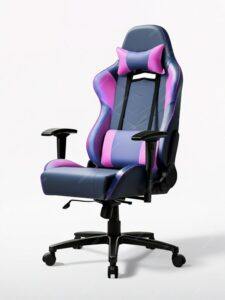A Comprehensive Guide
A gaming chair isn’t just a stylish addition to your setup; it’s an essential piece of equipment that can enhance your comfort and gaming experience. With the right chair, you can enjoy long gaming sessions without discomfort or strain. However, selecting the ideal gaming chair involves considering various factors to ensure it meets your specific needs. This guide covers the key features to look for when choosing a gaming chair, helping you make an informed decision.
1. Ergonomics and Comfort
a. Lumbar Support
-
- Proper lumbar support is crucial for maintaining a healthy posture and preventing back pain. Look for gaming chairs with adjustable lumbar support, either through built-in cushions or a detachable lumbar pillow. This feature helps keep your spine aligned and reduces strain during long gaming sessions.
b. Neck and Head Support
-
- A good gaming chair should provide adequate support for your neck and head. Many chairs come with adjustable headrests or pillows, which can help reduce neck strain and promote relaxation.
c. Seat Cushioning
-
- Comfortable cushioning is vital for extended periods of sitting. High-density foam or memory foam cushions provide excellent comfort and support. Ensure the seat is wide enough and adequately padded to prevent discomfort and pressure points.
d. Adjustability
-
- The ability to adjust various aspects of the chair is essential for a personalized fit. Look for the following adjustable features:
- Height Adjustment: Allows you to set the chair at a comfortable height relative to your desk and monitor.
- Armrest Adjustment: Adjustable armrests (4D, 3D, etc.) can be moved in multiple directions (up/down, forward/backward, left/right, angle) for optimal arm positioning.
- Backrest Recline: A recline feature allows you to adjust the backrest angle, providing a relaxed posture during breaks or while watching content.
- The ability to adjust various aspects of the chair is essential for a personalized fit. Look for the following adjustable features:
2. Build Quality and Durability
a. Frame Material
-
- The frame material determines the chair’s durability and weight capacity. Steel or aluminum frames offer robust support and long-lasting durability. Avoid chairs with plastic frames, as they may not withstand prolonged use.
b. Upholstery Material
-
- The upholstery material affects comfort, durability, and aesthetics. Common materials include:
- PU Leather: Offers a premium look and feel, is easy to clean, but may not be as breathable as fabric.
- Fabric: Breathable and comfortable, fabric chairs are ideal for hot climates but may require more maintenance to keep clean.
- Mesh: Provides excellent breathability, keeping you cool during long sessions.
- The upholstery material affects comfort, durability, and aesthetics. Common materials include:
c. Base and Casters
-
- A sturdy base and smooth-rolling casters are essential for stability and mobility. Look for chairs with a five-point base for balanced support. Casters should be durable and appropriate for your flooring type (e.g., carpet or hardwood).
3. Design and Aesthetics
a. Style and Color
-
- Gaming chairs come in various styles, from racing-inspired designs to more understated office-like models. Choose a style that complements your gaming setup and personal taste. Many chairs offer a range of color options, allowing you to match them with your existing decor.
b. Brand and Theme Collaborations
-
- Some gaming chairs are designed in collaboration with popular gaming brands, streamers, or franchises, featuring unique designs and branding. These can be a great choice for fans looking to express their fandom.
4. Additional Features
a. Tilt and Lock Mechanism
-
- A tilt and lock mechanism allows you to adjust the chair’s angle and lock it in place. This feature can help you find the perfect position for gaming or relaxing and adds versatility to the chair.
b. Footrest
-
- Some gaming chairs come with an extendable footrest, which can provide additional comfort when reclining. This feature is particularly beneficial for taking breaks or watching movies.
c. Built-in Speakers and Vibration
-
- High-end gaming chairs may include built-in speakers and vibration motors, enhancing the gaming experience with immersive sound and tactile feedback. This feature can add an extra layer of immersion, especially for racing or action games.
5. Size and Weight Capacity
a. Chair Size
-
- Ensure the gaming chair is appropriately sized for your body type. Many manufacturers provide size recommendations or offer different models for various body sizes. Consider the seat width, depth, and backrest height to ensure a comfortable fit.
b. Weight Capacity
-
- Check the chair’s weight capacity to ensure it can support your weight. This specification is crucial for safety and durability. Chairs with higher weight capacities are generally built with sturdier materials and provide better long-term support.
6. Price and Value 
a. Budget Considerations
-
- Gaming chairs range widely in price, from budget-friendly options to premium models with advanced features. Determine your budget and prioritize the features that are most important to you, such as ergonomics, material quality, and adjustability.
b. Value for Money
-
- Consider the overall value, including build quality, comfort, and durability. While higher-end chairs may come with a steeper price tag, they often provide better long-term value due to superior construction and features.
Conclusion
Choosing the right gaming chair involves balancing comfort, ergonomics, build quality, and additional features. A well-designed gaming chair can significantly enhance your gaming experience, providing the support and comfort needed for long sessions. By focusing on the key factors outlined in this guide, you can find a gaming chair that not only matches your aesthetic preferences but also supports your health and enhances your overall gaming setup.
